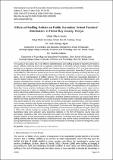| dc.description.abstract | The success of any policy lies in its effective implementation and staffing policies for teachers are meant to ensure sufficient teaching force that is equitably distributed in all public schools. Despite various staffing policies put by Ministry of Education (MOE) and Teachers Service Commission (TSC), in Kenya many schools are still understaffed and the available teachers are not equitably distributed. Homa-Bay County is currently understaffed by 1044 teachers spread across the six Sub-Counties despite regularly recruiting teachers as per the TSC policies. The deficit and inequitable distribution of teacher is therefore not due to non-employment but rather, due to implementation of staffing policies. The existence of deficit and inequitable distribution of teachers despite regular recruitment suggest a problem in the staffing policies and its implementation, and therefore warranted this research. The purpose of the study was to investigate the effects of teachers staffing policies on public secondary school teacher distribution in Homa-Bay County. The objectives of the study were to; examine the staffing policies for teachers in Kenya, determine the extent of implementation of the policies in Homa-Bay County, examine challenges influencing implementation of staffing policies, and to assess various measures being put in place to mitigate the situation. A conceptual framework was developed focusing on factors influencing implementation of staffing policies. The study employed ex-post facto research design with a study population of 283 head teachers of public secondary schools, 2318 teachers, 6 Sub-County Directors of Education and 1 TSC County Director of Education. Stratified sampling technique was used to select 30% of teachers and head teachers from the Sub Counties owing to the large number. Saturated sampling method was also used to sample the Sub-County and County TSC Director of Education. Questionnaires, interview schedule and document analysis guide formed instruments for data collection. Face and content Validity of instruments was ensured by experts in the Department of Educational Curriculum and Management of Jaramogi Oginga Odinga University of Science and Technology. Reliability of instruments was established through a pilot study in 10% of the schools outside the sample and weaknesses noted corrected before preparing the final copy. Quantitative data were analyzed using descriptive statistics in the form of frequency counts, mean and percentages. Qualitative data were transcribed and coded into themes and sub themes and analyzed using thematic analysis as they emerge based on research objectives. The finding of the study is useful in redesigning staffing policies under the new constitution of devolution and it also outline various considerations to be made during implementation of policies. The study has also contributed to knowledge on teacher management, policy formulation and implementation | en_US |

